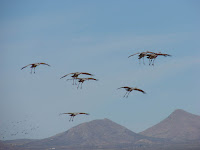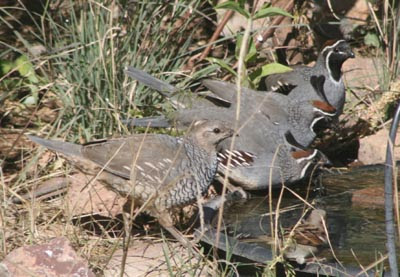There's breaking news on the southeastern Arizona section of the international border fence. Yesterday afternoon U.S. District Court Judge Ellen Segal Huvelle temporarily halted work already in progress on the part of the fence that passes through the San Pedro Riparian National Conservation Area. The judge based her ruling in part on the unprecedented speed with which the federal agencies had rushed the approval through to allow construction to begin "before anyone would wake up."
The Sierra Club and
Defenders of Wildlife filed the suit over the San Pedro portion of the fence out of concern that the barrier will alter the river's natural drainage patterns, increase erosion, destroy riparian vegetation, and disrupt archaeological sites. As designed, the San Pedro portion of the barrier would simply funnel foot traffic from the surrounding desert through the fragile riparian zone, magnifying its impact on the landscape and wildlife. The Bureau of Land Management's own assessment acknowledged these issues, yet the agency issued a permit to the Department of Homeland Security without a full environmental assessment or opportunities for public comment.
Birders have a more vested interest than many Americans in this particular border issue. The 700 miles of double-layered fence mandated by Congress and President Bush would cut a wide swath through the Lower Rio Grande Valley and southeastern Arizona, two of North America's top birding destinations. This contentious barrier would run through some of our most scenic and biologically diverse wildlife habitats, including national monuments, wildlife refuges, and forests, state parks, wilderness areas, and other public lands. We'll be laying waste to tens of thousands of acres of American soil, most of it wilderness. Migration corridors for earth-bound wildlife such as jaguars, ocelots, coatis, pronghorns, and desert bighorn sheep would be blocked. People, on the other hand, will readily find ways over, under, around, and through the fence, as they already do at our existing border barriers.
Many experts on national security, economics, and the environment believe that this border fence is a wretched, misbegotten boondoggle that's not going to protect us from terrorists and is little more than a finger in the dike to hold back immigration. Even those who don't give two hoots about wildlife and wilderness question the economics. The Department of Homeland Security estimates that the final construction cost of the 14-mile fence at San Diego will be $129 million, or
$9 million per mile [
source]. Multiply this times 700 to 1950 miles of our southern border, and you get
$6.3 to $17.6 billion out of our pockets. And that's not counting monitoring and maintenance into perpetuity. Is our economy so healthy and immigration such a dire threat that we can divert enormous amounts of money from programs that provide for the needs of our own citizens?
There's no doubt that we have to do something about illegal immigration. Its impact on our economy and health care system may be debatable, but there's no doubt that it's damaging public lands and wildlife habitat along the Mexican border. But ruining tens of thousands of acres of our own lands and straining our own struggling economy in a vain attempt to halt it amounts to cutting off our own nose to spite the illegal immigrants' faces. And I won't even get into the message it sends to our neighbors and the world.
The 10-day reprieve granted by Judge Huvelle is a small victory for American taxpayers, our public lands, Arizona's wildlife and habitats, and the birding community, but the battle for a sane, environmentally responsible approach to border security is far from over. Judge Huvelle's decision could be overturned by Homeland Security Secretary Michael Chertoff, who has been granted authority to waive any and all environmental laws to build the border fence.
If this one small part of the fence can be halted temporarily, there's a chance that the whole project can be delayed long enough for the country to come to its senses. Our precious borderlands and their wildlife need your support.
Please call and/or write your representatives in Congress to let them know that you support a more environmentally responsible approach to controlling immigration. --SW

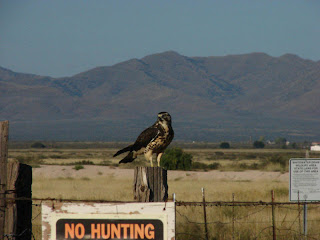
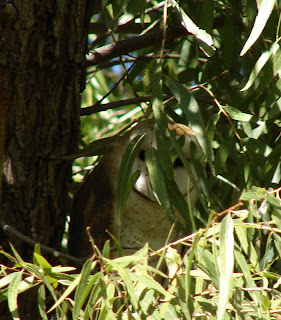
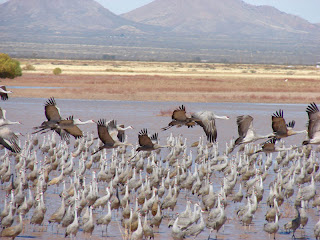 The cranes were so close that along with the constant bugling of the adults and chirping of juveniles, I could hear the flapping of their big wings as they moved about the playa. Suddenly I heard a whoosh like a jet plane overhead and an entire flight of cranes dropped out of the sky as fast as gravity could pull them. I love watching them drop their legs and cup their wings to parachute in, but this was a panic drop down to the water.
The cranes were so close that along with the constant bugling of the adults and chirping of juveniles, I could hear the flapping of their big wings as they moved about the playa. Suddenly I heard a whoosh like a jet plane overhead and an entire flight of cranes dropped out of the sky as fast as gravity could pull them. I love watching them drop their legs and cup their wings to parachute in, but this was a panic drop down to the water.